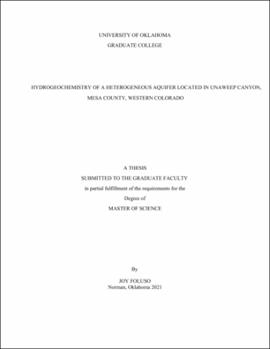| dc.description.abstract | The intersection of an increasing population, climate change, pollution, and over allocation of water continue to place additional strain on groundwater resources in arid regions. Groundwater in arid environments is particularly susceptible to overuse, and therefore a thorough understanding of groundwater sources and its contribution to sensitive ecosystems is vital. Unaweep Canyon, in the arid region of Colorado’s western slope, is a geologically unique site that harbors a buried paleovalley. The modern valley contains up to ~500 m of sediment fill comprising unconsolidated lacustrine, fluvial, and mass-wasting deposits, as well as possible lithified sedimentary rocks. We hypothesize that the unconsolidated layers in Unaweep Canyon aquifer are not hydro-geochemically linked and represent different, unique sources of groundwater. Our study focused on integrating published geologic information, geophysical data, and seasonal geochemical properties of groundwater and surface water to delineate multiple sources of water for both human and ecosystem needs. Several streams, seeps, Precambrian bedrock spring aquifers, and several domestic wells were sampled for metals, anions, and stable isotopes (18O and 2H) during spring, summer, and fall 2020 to identify seasonal effects. Piper plots also revealed that the Precambrian bedrock spring aquifers may be a sodium chloride or mixed type water, the spring is a sodium chloride type water, and the surface and groundwaters are magnesium-bicarbonate type waters. Furthermore, the isotopic composition of the seeps, West Creek, domestic well and Precambrian bedrock samples range from -14.06 to -15.16‰ δ18O and -103.5 to -109.46‰ δ2H, -12.89‰ to -14.7‰ δ18O and -99.3 to -106.68‰ δ2H, -13.64 to -14.77‰ δ18O and -102.4 to -105.94‰ δ2H, -14.27 to -15.39‰ δ18O and -108.7 to -112.78‰ δ2H respectively. Principal Component Analysis coupled with Spearman Correlation supported the existence of seasonal variation and multiple groundwater sources from all the sampling locations. Seasonal variability amongst in-situ water chemistry, metal and stable isotope results were attenuated, likely attributable to the drought conditions of 2020. Our results suggest the presence of multiple sources of groundwater within Unaweep Canyon, leading for the potential to utilize each source in a sustainable fashion. The findings and methodology used in our study may have applicability in similar hydrogeologic settings where alternate water sources. | en_US |
